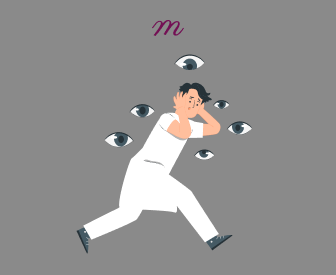Therapeutic boundaries refer to the clear and consistent limits that define the professional relationship between a therapist and a client. These boundaries ensure that therapy remains a safe, ethical, and goal-directed space. They cover aspects like time, place, and content of sessions, how and when communication happens, and the roles both therapist and client play. Boundaries are not about being distant or rigid, they create the structure that allows trust, safety, and therapeutic progress to flourish.
Last month after a tough session, I shut my laptop and just breathed. My client had just shared horrible childhood trauma, and I wanted to call them later to see if they were okay. I reached for my phone, then stopped. This moment, wanting to step outside our therapy hour reminded me why boundaries matter so much. They’re not just rules, they’re what makes therapy work.
After two years doing online counselling, I’ve learned that boundaries aren’t cold or mean like I once thought. They’re more like the invisible support beams that hold up everything we do.
What Boundaries Mean in Therapeutic Work
When I first started, setting boundaries felt uncomfortable. Saying no seemed harsh. Setting limits felt too strict.
I came across this line: “The frame around a painting isn’t there to trap the art—it’s there to help us see it better.” Boundaries in therapy aren’t walls keeping people out – they’re frameworks. They show where my job starts and stops. They help clients understand that our relationship, even though it gets very personal, exists for one reason: to help them heal.
I had a client who texted me constantly between our weekly sessions. She’d message about her bad days, family fights, even good news she wanted to share. While part of me wanted to be there for her 24/7, I instead used our next session to talk about building her own skills for handling tough moments. That wasn’t me abandoning her, it was helping her grow stronger.
Why Boundaries Matter in Mental Health Work
In therapy, people share their deepest pain with us. Clear boundaries create a safe container for this heavy work.
When clients know exactly what to expect—how long sessions last, when they can reach me, what we’ll talk about—they feel secure enough to do the hard, vulnerable work of therapy. Without these guidelines, therapy gets messy or even harmful.
For clients, fuzzy boundaries can make them feel unsafe or confused. For us therapists, poor boundaries often lead to burnout and ethical problems that could damage our careers.
Common Boundary Challenges in Therapy
After years of doing this work, I’ve noticed certain boundary issues keep coming up:
Running into clients outside therapy: I once bumped into a client at the grocery store near my house. They excitedly introduced me to their husband as “my therapist,” creating an awkward moment for everyone. Now I talk with local clients during our first meeting about what we’ll do if we see each other around town.
Time management struggles: When a client shows up 15 minutes late but still expects a full hour, or drops something huge right as we’re wrapping up, it tests my time boundaries. I’ve learned to kindly but firmly stick to our end time while acknowledging what they’re sharing matters.
Personal questions: Clients naturally get curious about our lives. One client directly asked about my faith, thinking it would help them open up about their own spiritual questions. Instead of answering, I asked what they hoped my answer would give them. This led to a much better conversation about what they were really looking for.
Gifts: I wonder if a client got me a gift how would I react – should I take it or not take it? So much grey here. As therapists we can try creating this boundary – rather than accepting the gift , thank them for their kindness while explaining why saying no actually protected our work together. We talked about other ways they could express thanks that kept our relationship healthy.
Navigating Boundaries in Online Therapy
In my two years of online work, I’ve faced unique boundary challenges. In virtual spaces, we lose the natural boundaries of a physical office—like separate waiting rooms or the drive between work and home. When therapy happens in bedrooms, at kitchen tables, or sometimes from cars, keeping clear boundaries gets both harder and more important.
Always being reachable: When clients can email, text, or message me on our therapy platform, they sometimes expect instant replies. I now clearly explain my “digital office hours”: “You can message anytime, but I only check messages during work hours and usually respond within a day.”
Privacy issues: Both therapists and clients struggle with keeping sessions private in shared living spaces. I’ve helped clients find creative solutions—like scheduling during times when their house is empty. I have my own therapy corner with a plain background and good sound control.
Technology boundaries: One client wanted to take sessions in a public place where there were too many people, network issues and noise. I had to address this directly: “I notice you’re out and about today. For therapy to really work, we need a private space where you can focus completely. Should we reschedule for when you’re at home?”
Transitions between clients: Without physical travel between sessions, I’ve found I need to create my own mental breaks. I leave 10 minutes between clients and do a quick ritual—standing up, stretching, looking out my window—to reset before the next person.
My online work has taught me that virtual boundaries don’t have to be stricter than in-person ones—they just need clearer communication.
Practical Strategies for Setting Healthy Boundaries
1. Start strong with intake paperwork
The therapy relationship begins before the first actual session. I use my paperwork and initial consultation to set clear expectations: session length, cancellation policies, what to do in emergencies, and how we’ll communicate. Setting the ground rules early prevents headaches later.
2. Know your own weak spots
We all have areas where our boundaries get shaky. Some therapists struggle with ending sessions on time; others have a hard time not rescuing clients in crisis. I’ve learned my weakness is over-extending myself when clients tell me how much I’ve helped them. Knowing this helps me watch for it.
3. Be consistent in your responses
When a client tests a boundary repeatedly—going over session time, asking for life advice, trying to be a friend—consistency matters most. I have found out that clear, kind repetition works better than either being too rigid or inconsistently flexible.
4. Get support from colleagues
We all have blind spots. Regular talks with trusted colleagues or peer supervisers help me spot when my boundaries might be slipping before small issues become big problems. Last month, discussing a case where I felt unusually invested helped me see some personal issues affecting my objectivity.
5. Have those awkward conversations
Some of the most important moments in therapy happen when addressing crossed boundaries directly. When a client recently sent me a friend request on Facebook, I brought it up in our next session: “I noticed you sent me a friend request. I’m curious what you were hoping for by connecting that way?” This opened up a valuable talk about their feelings about our relationship.
6. Know when to refer out
Sometimes despite our best efforts, therapy relationships develop unhealthy patterns. I’ve learned that referring a client to another therapist isn’t failing—it’s doing the right thing. When a client’s needs consistently push beyond what I can handle while maintaining good boundaries, a thoughtful referral helps everyone.
Boundaries in Crisis Situations
Emergencies can challenge even the best boundaries. During a crisis, I might extend a session, schedule extra support, or briefly check in between meetings. The key difference: these are planned, time-limited exceptions made for clear therapeutic reasons, not reactive boundary crossings.
Repairing Boundary Ruptures
Despite our best intentions, boundary mistakes happen. A comment taken too personally, a missed session without rescheduling, or getting too involved can shift the relationship in ways we don’t immediately notice. A well-handled mistake can model healthy relationship repair and build trust.
Steps to deal with ruptures:
- Name it without shame: When I notice I’ve shared too much or responded too casually, I acknowledge it: “I realize I may have shared more about my own experience than I usually would. I wonder how that felt for you?”
- Validate how it affected them: Clients may feel confused, hurt, or unsure how to respond. Validating this helps: “It makes sense that you’re unsure what to make of that moment. Your experience matters here.”
- Return to the therapy framework: Reaffirming the structure provides reassurance: “Let’s clarify again what our roles are and what you can expect from me, so we can feel grounded moving forward.”
Conclusion
The biggest lesson I’ve learned about therapeutic boundaries is that they aren’t restrictions—they’re expressions of care. Clear boundaries show clients that our relationship matters enough to protect.
When clients know exactly what to expect from me, they can focus on growing rather than testing limits or worrying about overwhelming me. And when I maintain healthy boundaries, I protect my ability to stay present and compassionate long-term.
Good boundaries don’t create distance between us and our clients—they create the safety that makes real connection possible, whether we’re sitting across from each other in an office or connecting through screens miles apart.
Resources
https://ensorahealth.com/blog/establishing-therapeutic-boundaries-with-patients
https://counsellingtutor.com/boundaries-in-counselling/
https://bluemoonseniorcounseling.com/therapist-tips-how-to-set-boundaries-in-a-therapeutic-setting/
https://positivepsychology.com/boundaries-psychology-therapy
https://cpbao.ca/wp-content/uploads/Professional-Boundaries-in-Health-Care-Relationships.pdf
Why other mental health professionals love Mentalyc

“It’s really giving me some good confidence … and areas of improvement to see nuances I didn’t see before.”

“Reading transcripts helps me tighten up and come across more the way I want to present myself to clients … it’s helped me improve and keep getting better.”
Licensed Marriage and Family Therapist

“There is a lot more feedback and suggestions in it than before … that makes things a little bit easier for me.”

“Using Alliance Genie has really improved my notes … It tells me what I’m doing and gives me an approach of what’s next.”







